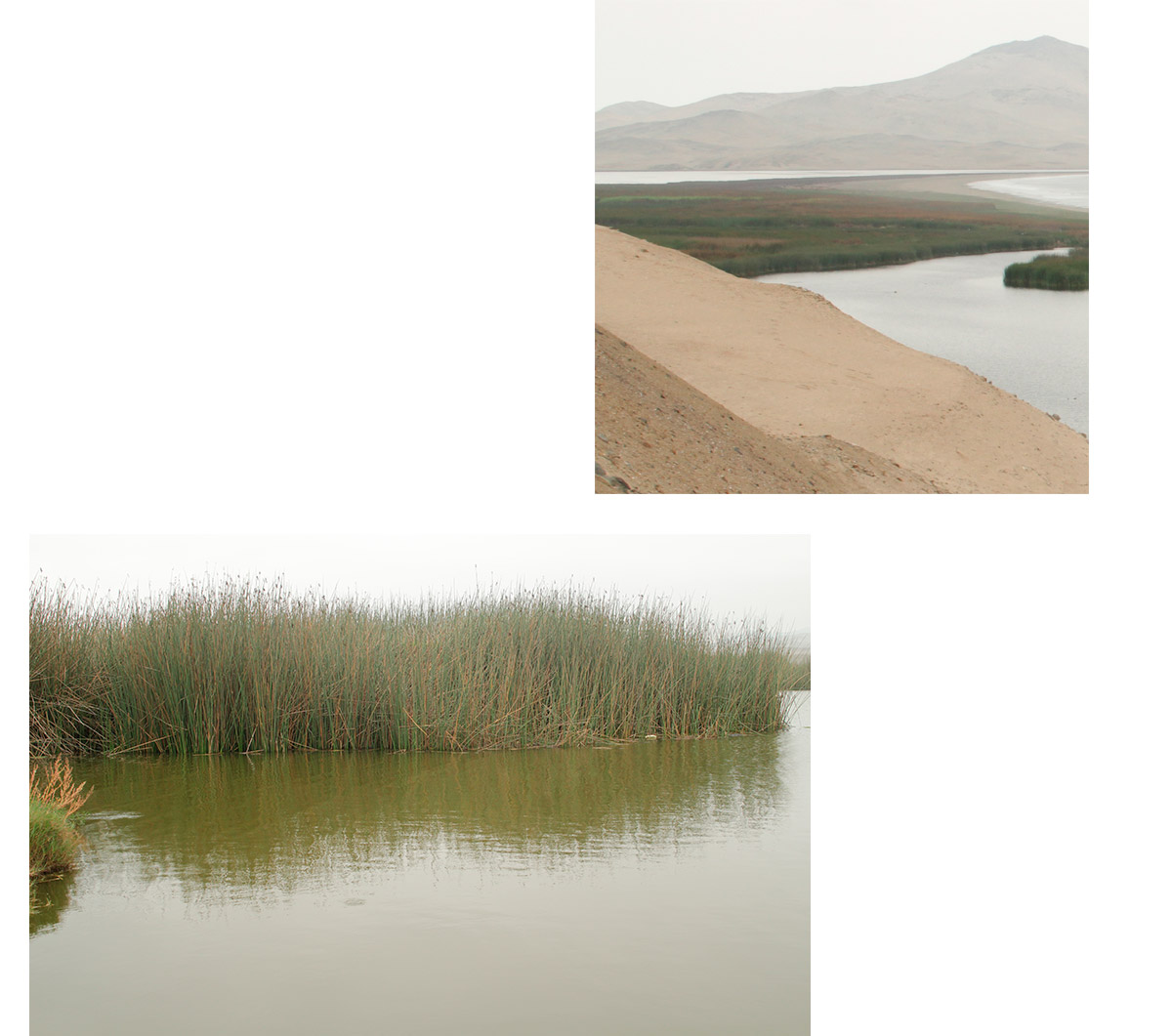
SUSTAINABLE ART: Water Ecosystem
Ana Teresa Barboza and Rafael Freyre seek to restore the symbolic value of water with and installation that combines art, design and crafts, based on an investigation of peruvian wetlands and traditional technologies for water treatment.
The societies that have inhabited the Peruvian desert have been obliged to establish a relationship with water given its scarcity. This allowed them to understand the water ecosystem and to develop technologies for the appropriate management of this valuable resource. In this way, they could inhabit arid terrestrial spaces, making them urban spaces and agricultural lands.
Throughout the pre-Columbian period, local cultures developed various systems of irrigation, capture and purification of water, such as puquios, pits, cultivation terraces and filtering galleries. A system that has drawn our attention, amongst the many, was the wachaque, a canal system that was used in the desert to plant and extract the totora and reed plants. These fibres grow naturally in the coast’s wetlands and serve to make utensils, furniture and architectural elements such as shicras. In addition, they have also been useful to purify water. Totora and reed are phytodepuration plants that contain rhizomes that grow parallel to the soil’s surface and absorb organic matter from the water.
The Project Water Ecosystem is an installation designed for the visitor to recognize this system and its processes, which involve the collection and purification of water, considering first and foremost the vegetable species which already fulfil these functions: the air plants, like the tillandsias, which capture the humidity of foggy areas and the water plants that inhabit the wetlands, such as totora and reed (junco), and the cleaning of their waters through their stems and roots. In this way, the installation integrates natural elements with ancestral and contemporary technologies of water management, with the intention of recovering this knowledge and projecting towards new practices in the future.
We are interested in recovering the relationship with the ecosystems of our territory, understanding their interactions and transformations. Likewise, we seek to create a ritual space with water, to restore its symbolic value within our communities and daily life. Water moves, flows and evaporates, changes constantly, like us. Through it, we can reflect and understand the cycles and transformations that we inhabit.
Ana Teresa Barboza
Rafael Freyre
“Ecosistema del agua” (Water Ecosystem) is the winning project of MAC LIMA National Prize Art and Innovation 2019. The museum called for artists and peruvian creators with proposals that innovate establishing relations between art, science and technology. The open call invited interdisciplinary projects that responded to technology in a wide sense: from recovery and appropriation of practices or traditional techniques, up till new media, and that take over contemporary society challenges with an artistic and critical vision.
After an exhaustive selection from the jury consisting of Natalija Boljsakov (Perú), Inti Guerrero (Colombia), Francesco Mariotti (Suiza) y Sanjay Sarma (India), MAC Lima choose Ecosistema del agua as the winning project. Moreover, there were two honorary mentions: Isla de Huacos by Camilo Nunas Ángeles Manga and Lorena Jiménez Lira, and Recirculación del flujo by Genietta Varsi, Nicola Varsi Lari and Gustavo Lari Rincón.
MAC LIMA National Prize Art and Innovation is an effort of the museum to contribute to the development of local contemporary art, with the support of Universidad de Ingeniería y Tecnología (UTEC) and under the sponsorship of BBVA Foundation of Lima.
PROJECT CONCEPT
ANA TERESA BARBOZA
RAFAEL FREYRE
COLLABORATING ARTISTS
STONEWORK
ROBERTO ROMÁN
TOTORA AND REED WEAVING
SAMUEL GOICOCHEA, EBER GOICOCHEA Y DAVID GOICOCHEA
CERAMIC WORK
ELIZABETH VÁSQUEZ
ADOBE
ERICK MALÁSQUEZ
TECHNICAL TEAM
PRODUCTION AND DESIGN DEVELOPMENT
ARQ. JAVIER RUBIO
PRODUCTION AND GENERAL MANAGEMENT
MARÍ RETAMOZO
COMMUNICATION
CLAUDIA MARTORELLET
VARIABLE FREQUENCY MOTOR SYSTEM
ING. LUIS ÁNGEL QUIJADA
VAPORIZATION SYSTEM INSTALLATION
HENRRY ALVARADO
LANDSCAPING ASSISTANCE
JONATHAN BEDOYA
HYDRAULICS SYSTEM DEVELOPMENT ASSISTANCE
ING. MANUEL MENDIETA
ING. FRANCISCO GUERRERO
PHOTOGRAPHY
ANA TERESA BARBOZA
RAFAEL FREYRE
JUAN PABLO MURRUGARA




Paisajes del desierto. Desert landscapes.

Junco de Albufera de Medio Mundo al norte de Lima. Reed from Albufera de Medio Mundo, a wetland in the central coast of Peru.

Arena de cuarzo - Carbón activado - Sillar. Quartz sand - Activated carbon - Sillar stone.



